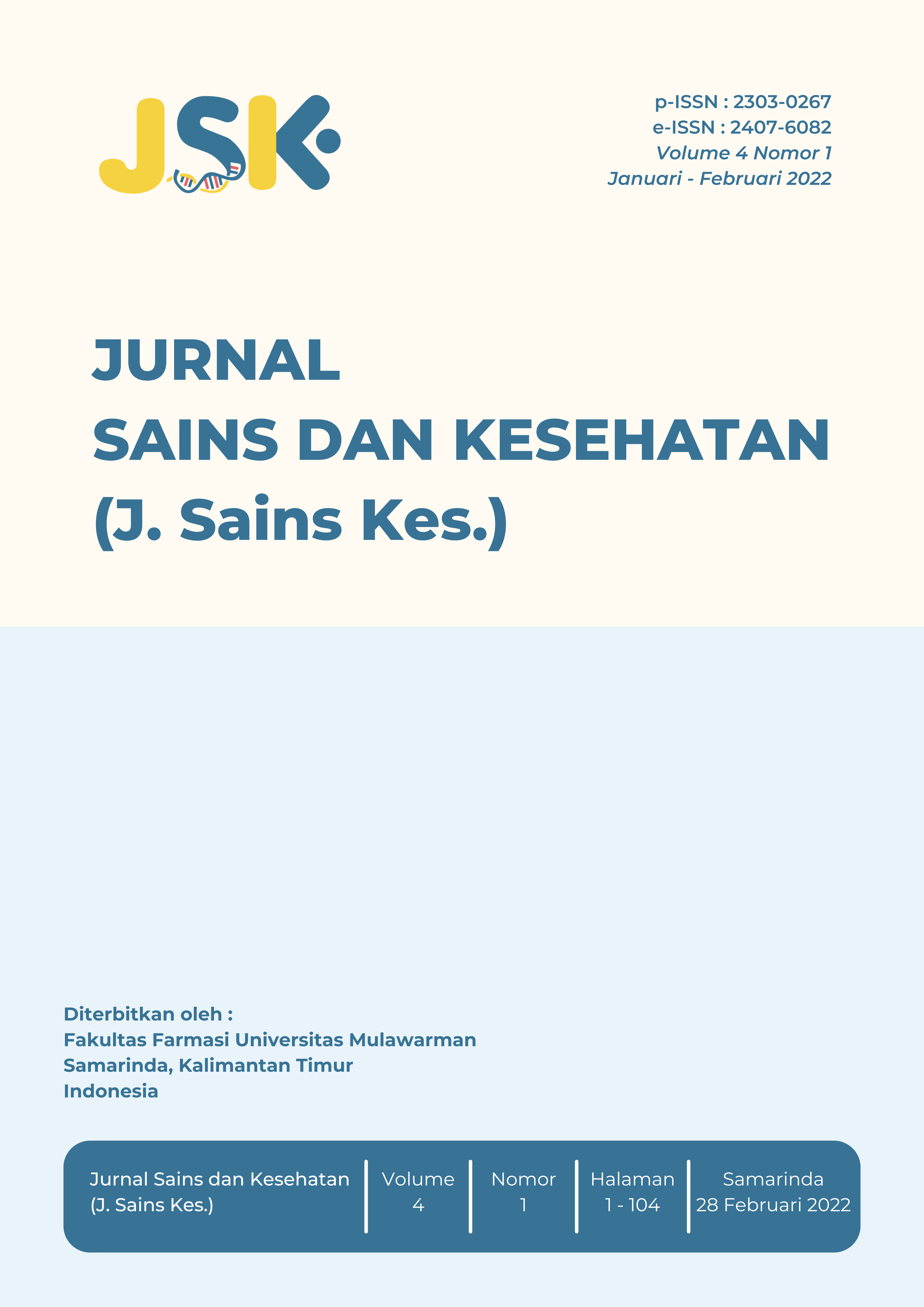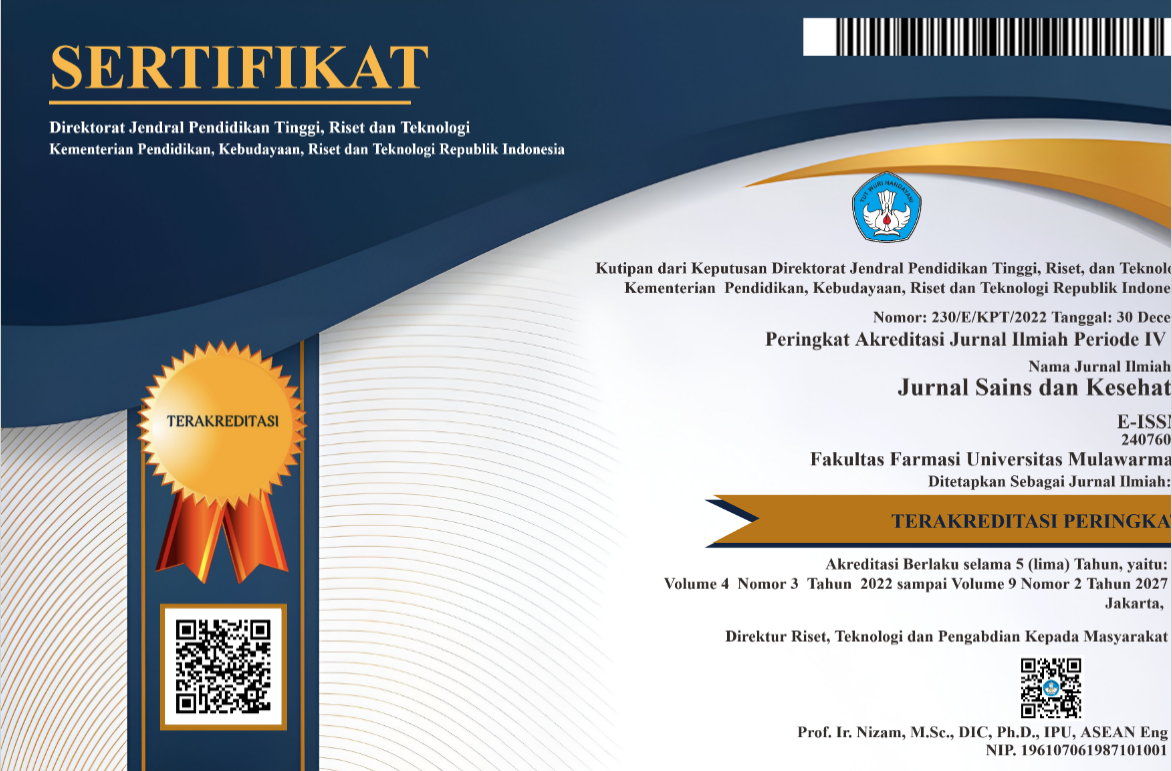Peran Disregulasi Imunitas dalam Terapi Kusta pada Area Endemis: Artikel Review
The Role of Immune Dysregulation in Leprosy Treatment in Endemic Areas: Review Article
Keywords:
kusta, disregulasi imunitas, terapi kustaAbstract
kusta.
References
C. Franco-Paredes and A. J. Rodriguez-Morales, “Unsolved matters in leprosy: A descriptive review and call for further research,” Annals of Clinical Microbiology and Antimicrobials, vol. 15, no. 1. 2016, doi: 10.1186/s12941-016-0149-x.
OMS, “Weekly epidemiological record. Global leprosy update, 2018: moving towards a leprosy,” Wkly. Epidemiol. Rec., vol. 94, no. August 2019, pp. 389–412, 2019, [Online]. Available: https://apps.who.int/iris/bitstream/handle/10665/326775/WER9435-36-en-fr.pdf.
WHO, Integrating Neglected tropical diseases into global health and development: fourth WHO report on neglected tropical diseases. 2017.
M. Malathi and D. M. Thappa, “Fixed-duration therapy in leprosy: Limitations and opportunities,” Indian Journal of Dermatology. 2013, doi: 10.4103/0019-5154.108029.
S. D. Santos, G. O. Penna, M. da C. N. Costa, M. S. Natividade, and M. G. Teixeira, “Leprosy in children and adolescents under 15 years old in an urban centre in Brazil,” Mem. Inst. Oswaldo Cruz, vol. 111, no. 6, pp. 359–364, 2016, doi: 10.1590/0074-02760160002.
M. C. A. Vieira, J. S. Nery, E. S. Paixão, K. V. Freitas de Andrade, G. Oliveira Penna, and M. G. Teixeira, “Leprosy in children under 15 years of age in Brazil: A systematic review of the literature,” PLoS Negl. Trop. Dis., 2018, doi: 10.1371/journal.pntd.0006788.
S. Sadhu and D. K. Mitra, “Emerging concepts of adaptive immunity in leprosy,” Frontiers in Immunology, vol. 9, no. APR. 2018, doi: 10.3389/fimmu.2018.00604.
T. H. M. Ottenhoff, “New pathways of protective and pathological host defense to mycobacteria,” Trends in Microbiology, vol. 20, no. 9. pp. 419–428, 2012, doi: 10.1016/j.tim.2012.06.002.
M. L. Palermo et al., “Increased expression of regulatory T cells and down-regulatory molecules in lepromatous leprosy,” Am. J. Trop. Med. Hyg., vol. 86, no. 5, pp. 878–883, 2012, doi: 10.4269/ajtmh.2012.12-0088.
K. Bobosha et al., “T-Cell Regulation in Lepromatous Leprosy,” PLoS Negl. Trop. Dis., vol. 8, no. 4, 2014, doi: 10.1371/journal.pntd.0002773.
J. R. de Sousa, M. N. Sotto, and J. A. S. Quaresma, “Leprosy as a complex infection: Breakdown of the Th1 and Th2 immune paradigm in the immunopathogenesis of the disease,” Frontiers in Immunology, vol. 8, no. NOV. 2017, doi: 10.3389/fimmu.2017.01635.
F. R. S. Prakoeswa et al., “Correlation Analysis between Household Hygiene and Sanitation and Nutritional Status and Female Leprosy in Gresik Regency,” Dermatol. Res. Pract., vol. 2020, 2020, doi: 10.1155/2020/4379825.
P. A. M. Schreuder, S. Noto, and J. H. Richardus, “Epidemiologic trends of leprosy for the 21st century,” Clin. Dermatol., vol. 34, no. 1, pp. 24–31, 2016, doi: 10.1016/j.clindermatol.2015.11.001.
World Health Organization, “Weekly epidemiological record. Global leprosy update, 2018: moving towards a leprosy,” Wkly. Epidemiol. Rec., vol. 94, no. August 2019, pp. 389–412, 2019, doi: 94 (?35/36)?, 389 - 411.
M. B. Santos et al., “Distinct Roles of Th17 and Th1 Cells in Inflammatory Responses Associated with the Presentation of Paucibacillary Leprosy and Leprosy Reactions,” Scand. J. Immunol., vol. 86, no. 1, pp. 40–49, 2017, doi: 10.1111/sji.12558.
Q. A. Cendaki, “The Findings of Mycobacterium Leprae DNA Existence in the Air as an Indication of Leprosy Transmission from Respiratory System,” J. Kesehat. Lingkung., vol. 10, no. 2, p. 181, 2018, doi: 10.20473/jkl.v10i2.2018.181-190.
L. R. S. Kerr-Pontes, M. L. Barreto, C. M. N. Evangelista, L. C. Rodrigues, J. Heukelbach, and H. Feldmeier, “Socioeconomic, environmental, and behavioural risk factors for leprosy in North-east Brazil: Results of a case-control study,” Int. J. Epidemiol., vol. 35, no. 4, pp. 994–1000, 2006, doi: 10.1093/ije/dyl072.
Ulina, DR, Pramuningtyas, Ratih, Dasuki, MS, Prakoeswa, FR. "Personal Hygiene dan Status Gizi Sebagai Faktor Risiko Kusta Anak". Proceeding Book National Symposium and workshop Continuing Medical Education XIV. FK UMS. 2021.
R. Ratnawati, Rahfiludin, MZ, and Kartasurya, “Relationship between Home Physical and Non-Physical Environment with Anti Phenolic Glicolipid-1 IgM Antibody Levels in Children of Leprosy Patients (House Physical and Non-Physical Environment Associated with Levels of IgM Anti Phenolic Glicolipid-1 (PGL-,” Period. Ski. Heal. Gend., vol. 30, no. 3, pp. 201–207, 2018.
M. PrabhuDas et al., “Immune mechanisms at the maternal-fetal interface: Perspectives and challenges,” Nature Immunology, vol. 16, no. 4. pp. 328–334, 2015, doi: 10.1038/ni.3131.
F. R. S. Prakoeswa et al., “Comparison of IL-17 and FOXP3+ Levels in Maternal and Children Leprosy Patients in Endemic and Nonendemic Areas,” Interdiscip. Perspect. Infect. Dis., vol. 2021, 2021, doi: 10.1155/2021/8879809.
S. Sadhu, B. K. Khaitan, B. Joshi, U. Sengupta, A. K. Nautiyal, and D. K. Mitra, “Reciprocity between Regulatory T Cells and Th17 Cells: Relevance to Polarized Immunity in Leprosy,” PLoS Negl. Trop. Dis., vol. 10, no. 1, 2016, doi: 10.1371/journal.pntd.0004338.
C. Saini, M. Tarique, R. Rai, A. Siddiqui, N. Khanna, and A. Sharma, “T helper cells in leprosy: An update,” Immunology Letters, vol. 184. pp. 61–66, 2017, doi: 10.1016/j.imlet.2017.02.013.
V. P. Dwivedi et al., “Diet and nutrition: An important risk factor in leprosy,” Microb. Pathog., vol. 137, no. August, p. 103714, 2019, doi: 10.1016/j.micpath.2019.103714.
C. M. P. Vázquez et al., “Micronutrientes que influyen en la respuesta immune en la lepra,” Nutr. Hosp., vol. 29, no. 1, pp. 26–36, 2014, doi: 10.3305/nh.2014.29.1.6988.
N. Z. Gammoh and L. Rink, “Zinc in infection and inflammation,” Nutrients. 2017, doi: 10.3390/nu9060624.
S. Oktaria, N. S. Hurif, W. Naim, H. B. Thio, T. E. C. Nijsten, and J. H. Richardus, “Dietary diversity and poverty as risk factors for leprosy in Indonesia: A case-control study,” PLoS Negl. Trop. Dis., vol. 12, no. 3, 2018, doi: 10.1371/journal.pntd.0006317.
S. Chaitanya, M. Lavania, R. P. Turankar, S. R. Karri, and U. Sengupta, “Increased serum circulatory levels of interleukin 17F in type 1 reactions of leprosy,” J. Clin. Immunol., vol. 32, no. 6, pp. 1415–1420, 2012, doi: 10.1007/s10875-012-9747-3.
Downloads
Published
Issue
Section
How to Cite
Similar Articles
- Putri Dina Mahera Laily , Laporan Kasus: Terapi Covid-19 pada Pasien dengan Komorbid Hipertensi , Jurnal Sains dan Kesehatan: Vol. 4 No. 2 (2022): J. Sains Kes.
- Luthfa Hubbalkhairi Ulfa, Andriansyah Andriansyah, Abdillah Iskandar, Hubungan Kadar Hemoglobin Sebelum dan Selama Terapi Radiasi dengan Respon Tumor pada Pasien Kanker Serviks di RSUD Abdul Wahab Sjahranie Samarinda , Jurnal Sains dan Kesehatan: Vol. 3 No. 6 (2021): J. Sains Kes.
- Fauza Nisfu Laili, Devi Ristian Octavia, Muhtaromah Muhtaromah, Hubungan Kepatuhan Pengobatan TB-RO terhadap Outcome Terapi Pasien Tuberkulosis di Rumah Sakit Muhammadiyah Lamongan , Jurnal Sains dan Kesehatan: Vol. 5 No. 5 (2023): J. Sains Kes.
- Risna Agustina, Andreanus A. Soemardji, Efektivitas Akupunktur “GI” terhadap Pengobatan Stres pada Pasien di Klinik Akupunktur Sukamenak dan UPT Layanan Kesehatan Bumi Medika Ganesa ITB , Jurnal Sains dan Kesehatan: Vol. 1 No. 5 (2016): J. Sains Kes.
- Nelson Sudiyono, Irene Vanessa, Pengaruh Pemberian Terapi Fisik Dada pada Pasien Geriatri dengan Pneumonia terhadap Luaran Klinis di Unit Perawatan Intensif Rumah Sakit Atma Jaya , Jurnal Sains dan Kesehatan: Vol. 6 No. 3 (2025)
- Annisa Fitri Fadhilah, Djoen Herdianto, Muhammad Khairul Nuryanto, Perbedaan Nilai Fraksi Ejeksi Ventrikel Kiri (LVEF) Pasien IMA-EST yang Menjalani Terapi Reperfusi dengan Fibrinolitik dan IKPP di RSUD Abdul Wahab Sjahranie Samarinda , Jurnal Sains dan Kesehatan: Vol. 3 No. 2 (2021): J. Sains Kes.
- Aliya Khadijah Kemaleratu, Yuliana Rahmah Retnaningrum, Yudanti Riastiti, Tingkat Keberhasilan Terapi Radioiodin Pertama pada Pasien Graves’ Disease , Jurnal Sains dan Kesehatan: Vol. 6 No. 1 (2025)
- Warrantia Citta Citti Putri, Nishia Waya Meray, Indah Woro Utami, Pengaruh Pemberian Minyak Ikan terhadap Hasil Terapi Pasien Skizofrenia Rawat Inap Berdasarkan Skala PANSS , Jurnal Sains dan Kesehatan: Vol. 3 No. 6 (2021): J. Sains Kes.
- Ni Made Suastini, Fauna Herawati, Efikasi dan Keamanan dari Pancreatic Enzyme Replacement Therapy pada Pasien Cystic Fibrosis : Sebuah Kajian Sistematis , Jurnal Sains dan Kesehatan: Vol. 3 No. 4 (2021): J. Sains Kes.
- Azizah Salsa Billa, Sjarif Ismail, Yenny Abdulla, Pengaruh Manipulasi Tangan secara Mandiri terhadap Nyeri Ulu Hati pada Mahasiswa Fakultas Kedokteran Universitas Mulawarman , Jurnal Sains dan Kesehatan: Vol. 5 No. 3 (2023): J. Sains Kes.
You may also start an advanced similarity search for this article.




